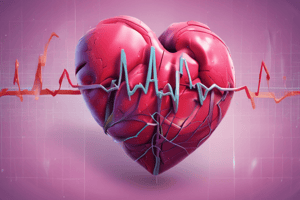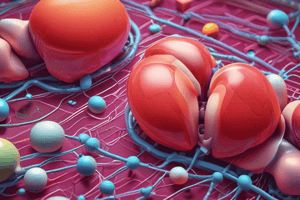Podcast
Questions and Answers
What is the name of the heart's main pacemaker?
What is the name of the heart's main pacemaker?
SA node
What is the normal heart rate range in beats per minute (bpm)?
What is the normal heart rate range in beats per minute (bpm)?
60-100 bpm
What are the important components of electrolyte balance that influence mechanical and electrical heart functions?
What are the important components of electrolyte balance that influence mechanical and electrical heart functions?
- Sodium, Calcium, Potassium, and Magnesium (correct)
- Chloride, Phosphate, Sodium, and Potassium
- Iron, Zinc, Potassium, and Magnesium
- Calcium, Phosphorus, Magnesium, and Sodium
What are the possible causes of sinus tachycardia?
What are the possible causes of sinus tachycardia?
Sinus tachycardia is always accompanied by symptoms.
Sinus tachycardia is always accompanied by symptoms.
What does the acronym 'SVT' stand for?
What does the acronym 'SVT' stand for?
Supraventricular tachycardia is always caused by underlying heart disease.
Supraventricular tachycardia is always caused by underlying heart disease.
What are the possible symptoms that some patients with SVT may experience?
What are the possible symptoms that some patients with SVT may experience?
What is the purpose of vagal maneuvers?
What is the purpose of vagal maneuvers?
Which of the following is a common vagal maneuver used to potentially slow down a fast heart rate?
Which of the following is a common vagal maneuver used to potentially slow down a fast heart rate?
Cardioversion is a procedure that involves delivering a controlled electrical shock to the heart to reset the rhythm.
Cardioversion is a procedure that involves delivering a controlled electrical shock to the heart to reset the rhythm.
What is the purpose of catheter ablation?
What is the purpose of catheter ablation?
What are the three types of AV blocks?
What are the three types of AV blocks?
What is the main characteristic of first-degree heart block?
What is the main characteristic of first-degree heart block?
What are the possible causes of first-degree heart block?
What are the possible causes of first-degree heart block?
What is the main characteristic of second-degree AV block Mobitz I (Wenckebach)?
What is the main characteristic of second-degree AV block Mobitz I (Wenckebach)?
What are some possible causes of second-degree AV block Mobitz I (Wenckebach)?
What are some possible causes of second-degree AV block Mobitz I (Wenckebach)?
What is the main characteristic of second-degree AV block Mobitz II?
What is the main characteristic of second-degree AV block Mobitz II?
Second-degree AV block Mobitz II is typically less serious than second-degree AV block Mobitz I.
Second-degree AV block Mobitz II is typically less serious than second-degree AV block Mobitz I.
What are some possible causes of second-degree AV block Mobitz II?
What are some possible causes of second-degree AV block Mobitz II?
What is the main characteristic of third-degree heart block (complete heart block)?
What is the main characteristic of third-degree heart block (complete heart block)?
What are some possible causes of third-degree heart block (complete heart block)?
What are some possible causes of third-degree heart block (complete heart block)?
Ventricular fibrillation (V-fib) is a life-threatening condition where the ventricles quiver instead of pumping blood effectively.
Ventricular fibrillation (V-fib) is a life-threatening condition where the ventricles quiver instead of pumping blood effectively.
What are some possible causes of ventricular fibrillation (V-fib)?
What are some possible causes of ventricular fibrillation (V-fib)?
Immediate CPR and defibrillation are crucial for survival in cases of ventricular fibrillation.
Immediate CPR and defibrillation are crucial for survival in cases of ventricular fibrillation.
What is cardiac ablation?
What is cardiac ablation?
Flashcards
Sinus Tachycardia
Sinus Tachycardia
A condition where the heart beats too fast, exceeding 100 beats per minute.
Causes of Sinus Tachycardia
Causes of Sinus Tachycardia
Sinus tachycardia can be caused by various factors, including exercise, anxiety, fever, medications, anemia, heart failure, dehydration, and shock.
Tachyheas
Tachyheas
A collection of possible causes of a fast heart rate, helpful for remembering common triggers of tachycardia.
Management of Sinus Tachycardia
Management of Sinus Tachycardia
Signup and view all the flashcards
Sinus Bradycardia
Sinus Bradycardia
Signup and view all the flashcards
Causes of Sinus Bradycardia
Causes of Sinus Bradycardia
Signup and view all the flashcards
Atrial Fibrillation (A-Fib)
Atrial Fibrillation (A-Fib)
Signup and view all the flashcards
Prevalence of Atrial Fibrillation
Prevalence of Atrial Fibrillation
Signup and view all the flashcards
Impact of Atrial Fibrillation on Heart Function
Impact of Atrial Fibrillation on Heart Function
Signup and view all the flashcards
Risks Associated with Atrial Fibrillation
Risks Associated with Atrial Fibrillation
Signup and view all the flashcards
ECG of Atrial Fibrillation
ECG of Atrial Fibrillation
Signup and view all the flashcards
Causes of Atrial Fibrillation
Causes of Atrial Fibrillation
Signup and view all the flashcards
Treatment of Atrial Fibrillation
Treatment of Atrial Fibrillation
Signup and view all the flashcards
Management of Stable Atrial Fibrillation
Management of Stable Atrial Fibrillation
Signup and view all the flashcards
Management of Unstable Atrial Fibrillation
Management of Unstable Atrial Fibrillation
Signup and view all the flashcards
Cardioversion
Cardioversion
Signup and view all the flashcards
Medications and Procedures for Atrial Fibrillation
Medications and Procedures for Atrial Fibrillation
Signup and view all the flashcards
Rate Control Medications
Rate Control Medications
Signup and view all the flashcards
Rhythm Control Medications
Rhythm Control Medications
Signup and view all the flashcards
Anticoagulants for Atrial Fibrillation
Anticoagulants for Atrial Fibrillation
Signup and view all the flashcards
Cardiac Ablation
Cardiac Ablation
Signup and view all the flashcards
Lifestyle Modifications for Atrial Fibrillation
Lifestyle Modifications for Atrial Fibrillation
Signup and view all the flashcards
Supraventricular Tachycardia (SVT)
Supraventricular Tachycardia (SVT)
Signup and view all the flashcards
ECG of SVT
ECG of SVT
Signup and view all the flashcards
Typical Heartbeat
Typical Heartbeat
Signup and view all the flashcards
Supraventricular Tachycardia
Supraventricular Tachycardia
Signup and view all the flashcards
Management of SVT
Management of SVT
Signup and view all the flashcards
Vagal Maneuvers
Vagal Maneuvers
Signup and view all the flashcards
Types of Vagal Maneuvers
Types of Vagal Maneuvers
Signup and view all the flashcards
Cardioversion for SVT
Cardioversion for SVT
Signup and view all the flashcards
Catheter Ablation for SVT
Catheter Ablation for SVT
Signup and view all the flashcards
Study Notes
Arrhythmias
- Arrhythmia is an irregular heartbeat
- Prepared by Dr. Rebar Y. Abdullah, Assistant Professor, University of Duhok- College of Nursing, PhD Family and Community Health
- The SA node is the heart's primary pacemaker, generating impulses at 60-100 bpm.
- The AV node acts as a backup pacemaker, firing at 40-60 bpm if the SA node fails.
- Bundle branches divide into right and left, activating at 30-40 bpm.
- Purkinje fibers activate at 30-40 bpm.
- The electrical functions of the heart are influenced by sodium, calcium, potassium, and magnesium.
- Sinus tachycardia is a faster-than-normal heartbeat (>100 bpm) originating from the SA node.
- Causes of sinus tachycardia include exercise, anxiety, fever, hypoxemia, hypovolemia, or cardiac failure.
- Sinus bradycardia is slower than normal (<60 bpm) originating from the SA node.
- Causes of sinus bradycardia can include drugs, vagal stimulation, hypoendocrine states, hypothermia, or sinus node involvement in MI.
- Atrial fibrillation (A-Fib) is uncontrolled electrical activity in the atria, causing a rapid and irregular heartbeat.
- Atrial fibrillation often has a rate greater than 100 bpm, with an irregular rhythm
- Symptoms of atrial fibrillation often include fatigue, dizziness, or syncope
- Types of causes include after heart surgery, heart problems, COPD, or sleep apnea
- Treatment for atrial fibrillation depends on the patient's stability and symptoms.
- In stable patients, monitoring heart rate less than 100 bpm is important
- Unstable patients who have dropped blood pressure, reduced cardiac output, and an uncontrolled heart rate (over 100 bpm) require synchronized cardioversion.
Supraventricular Tachycardia (SVT)
- An arrhythmia with a rapid rate, making P waves hard to see.
- Rate is 150-250 bpm; rhythm regular; P waves usually buried in preceding T waves and hard to see; PR interval is usually not measurable; QRS is normal (0.06-0.10 sec) but may be wide if conducted abnormally.
- Causes include caffeine, nicotine, stress, or anxiety for healthy adults.
- Some patients may experience angina, hypotension, lightheadedness, palpitations, or intense anxiety.
- Management involves vagal maneuvers, intravenous beta-blockers, diltiazem, verapamil (class II), or synchronized cardioversion.
Vagal Maneuvers
- Physical actions to slow heart rate.
- Actions include coughing, bearing down, and raising one's legs to 45 degrees.
- Avoid in patients with low blood pressure, chest pain, shortness of breath, or oxygen shortages.
Cardioversion
- A procedure to reset the heart rhythm using electrical energy.
Catheter Ablation
- A procedure to destroy abnormal heart tissue causing arrhythmias.
- Uses thin, flexible tubes (catheters) inserted through a blood vessel
Atrioventricular (AV) Blocks
- Conduction defects within the AV junction, impairing AV node function.
- First-degree AV block: Slowing of electrical signal through the AV node; prolonged PR interval (usually >0.20 seconds); rate typically <60 bpm; QRS complex and rhythm is normal.
- Second-degree AV block Mobitz Type I (Wenckebach): Gradual lengthening of PR intervals until an atrial impulse is not conducted; rate is usually <60 bpm; pattern is regular until dropped QRS complexes; ventricular rhythm is irregular.
- Second-degree AV block Mobitz Type II: Constant PR interval, with occasional dropped QRS complexes; rate varies; ventricular rhythm is irregular.
- Third-degree/complete AV block: Electrical signal from atria doesn't reach ventricles; P waves and QRS complexes are independent; ventricular rate is often <40 bpm and irregular.
Ventricular Fibrillation (V-Fib)
- Rapid, chaotic ventricular rhythm, with no cardiac output or pulse.
- No P waves, QRS complexes, T waves, or PR intervals can be seen.
- Causes often include heart disease, low/high potassium levels, hypoxia, and drug overdose.
- Treatment is emergency CPR, oxygen, defibrillation, epinephrine, and antiarrhythmic medications.
Pacemakers
- Single chamber pacemakers stimulate only the lower right ventricle.
- Dual chamber pacemakers stimulate both the upper and lower right ventricles.
- Biventricular pacemakers (cardiac resynchronization therapy) stimulate both ventricles to help with heart failure.
Studying That Suits You
Use AI to generate personalized quizzes and flashcards to suit your learning preferences.




